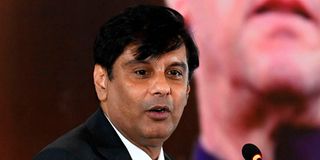Revealed: Pakistani pathologists find crucial evidence missed by Kenyan medics

The late Pakistani journalist Arshad Sharif. He was shot dead at a police roadblock on the Nairobi-Magadi road.
Eight pathologists conducting a second post-mortem on the Pakistani journalist who was killed in Kenya last week found a bullet lodged in his chest, Nation can now reveal.
The pathologists from the Pakistan Institute of Medical Sciences (Pims) said they had found a metal, which they later identified as a bullet, when they conducted the post-mortem on Wednesday last week, after Mr Arshad Sharif’s body arrived in his home country. They handed the bullet to police officers in Pakistan.
Investigators said they believe the bullet is a crucial lead in the ongoing investigations into the murder of Mr Sharif, which has been marred by controversy.
It is unclear whether the pathologists who conducted the post-mortem in Kenya last Tuesday, had noticed the bullet and if so, if they deliberately left it there.
Nation is in possession of the post-mortem report filed in Pakistan which states that Mr Sharif, 50, died 10 to 30 minutes after he was shot in the brain and lung.
“The board is of the opinion that the deceased died due to firearm injuries that caused damage to the brain and the right lung,” the report read.
It added that all the injuries were ante-mortem in nature and that they could lead to an ordinary cause of death. Ante-mortem injuries usually refer to events occurring before death.

Members of Shiite Ulema Council, a Shiite Muslim religious-political organization, light candles for Arshad Sharif, a Pakistani journalist killed in Kenya, during a ceremony in Karachi on October 29, 2022.
The pathologists said the first post-mortem was conducted two to three days after the journalist had died.
The body was taken from the Quaid-e-Azam International Hospital in Islamabad by two police officers, only identified as Mr Ramna and Mr Shahbaz.
“His body was brought to the hospital while wrapped in a blanket and a bed sheet. A Y-shaped post-mortem stitched wound, 28 centimetres which starts from the shoulder to his stomach,” the report read.
In Kenya, pathologists said the journalist was killed due to a gunshot between the shoulder and the head.
Chief Government Pathologist Johansen Oduor told Nation that if a bullet is found in a body during a post-mortem, it is usually removed and handed over to investigating officers.
He explained that if there was a bullet in the body of the journalist, then it would be important if the entry point was also shown.
“There is a need to show where the bullet entered the body. We saw an entry and exit point of the bullet,” Dr Oduor said.
Addressing the media after the autopsy conducted in Kenya, Pakistani High Commissioner to Kenya Saqlain Syeda said the television journalist died from gunshot wounds.
“It’s very unfortunate and investigations will be done after this. We have already done the post-mortem and we are trying to send the body back home,” she said.
Back in Kenya, investigations are going on and four officers attached to the General Service Unit (GSU) at the Magadi Training College were questioned last Tuesday and Wednesday. Their firearms were confiscated by detectives attached to the Directorate of Criminal Investigations (DCI).

Mourners gather around the coffin of Pakistani journalist Arshad Sharif, who was shot dead by police in Kenya, during his funeral ceremony at the Faisal mosque in Islamabad on October 27, 2022.
On Tuesday, Rift Valley Directorae of criminal Investigations boss Mwenda Meme led detectives to the place where the journalist was said to have been shot by the GSU officers.
They then went to Ammodump Kwenia, an entertainment spot that has a shooting range that’s open to the public.
Mistaken identity
The establishment has a tented lodge, archery, off-road biking trails, and camping site.
It also offers game drives and farm tours.
Mr Sharif was last seen alive at the establishment, which is a favourite hangout for Pakistani and Indian nationals.
The Kenyan police have maintained that the journalist’s shooting was a case of mistaken identity. They also claimed that the vehicle in which he was a passenger was signalled to stop, but instead started speeding off.
It is unclear why the officers decided to shoot at the vehicle, whose registration number is KDG 200M, driven by Khurram Ahmed, a friend of Mr Sharif.
The GSU officers were said to have barricaded the road using stones as they pursued a motor vehicle (registration number KDJ 700F), which had been stolen from the Nairobi city centre.
It also emerged that the journalist’s family had asked him to leave the country and seek political asylum elsewhere.
Mr Sharif, who had arrived in Kenya from London, said he had received death threats after exposing corruption in his home country.
He had first fled to Dubai.
The journalist was a critic of the Pakistani government led by Prime Minister Shehbaz Sharif, who took over in April following the ouster of his predecessor, Mr Imran Khan.





